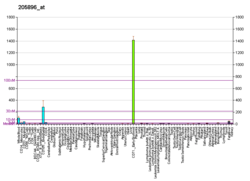SLC22A4
Solute carrier family 22, member 4, also known as SLC22A4, is a human gene; the encoded protein is known as the ergothioneine transporter.[5]
Function
The encoded protein is an integral protein of the plasma membrane containing 12 transmembrane segments. The first functional designation of this protein was OCTN1 ("organic cation transporter, novel, type 1"), but efficiency of transport for organic cations (e.g., tetraethylammonium) is very low.[6] The transport efficiency for carnitine is also negligible. Instead, the protein is responsible for the cotransport of sodium ions and ergothioneine, which is an antioxidant, into cells.[7] Thus, a more appropriate functional designation is ETT ("ergothioneine transporter").
Interactions
SLC22A4 has been shown to interact with PDZK1.[8]
See also
References
- GRCh38: Ensembl release 89: ENSG00000197208 - Ensembl, May 2017
- GRCm38: Ensembl release 89: ENSMUSG00000020334 - Ensembl, May 2017
- "Human PubMed Reference:". National Center for Biotechnology Information, U.S. National Library of Medicine.
- "Mouse PubMed Reference:". National Center for Biotechnology Information, U.S. National Library of Medicine.
- "Entrez Gene: SLC22A4 solute carrier family 22 (ergothioneine transporter), member 4".
- Grigat S, Harlfinger S, Pal S, Striebinger R, Golz S, Geerts A, Lazar A, Schömig E, Gründemann D (Jul 2007). "Probing the substrate specificity of the ergothioneine transporter with methimazole, hercynine, and organic cations". Biochemical Pharmacology. 74 (2): 309–16. doi:10.1016/j.bcp.2007.04.015. PMID 17532304.
- Gründemann D, Harlfinger S, Golz S, Geerts A, Lazar A, Berkels R, Jung N, Rubbert A, Schömig E (Apr 2005). "Discovery of the ergothioneine transporter". Proceedings of the National Academy of Sciences of the United States of America. 102 (14): 5256–61. doi:10.1073/pnas.0408624102. PMC 555966. PMID 15795384.
- Gisler SM, Pribanic S, Bacic D, Forrer P, Gantenbein A, Sabourin LA, Tsuji A, Zhao ZS, Manser E, Biber J, Murer H (Nov 2003). "PDZK1: I. a major scaffolder in brush borders of proximal tubular cells". Kidney International. 64 (5): 1733–45. doi:10.1046/j.1523-1755.2003.00266.x. PMID 14531806.
Further reading
- Xuan W, Lamhonwah AM, Librach C, Jarvi K, Tein I (Jun 2003). "Characterization of organic cation/carnitine transporter family in human sperm". Biochemical and Biophysical Research Communications. 306 (1): 121–8. doi:10.1016/S0006-291X(03)00930-6. PMID 12788076.
- Yamada R, Tokuhiro S, Chang X, Yamamoto K (Sep 2004). "SLC22A4 and RUNX1: identification of RA susceptible genes". Journal of Molecular Medicine. 82 (9): 558–64. doi:10.1007/s00109-004-0547-y. PMID 15184985.
- Silverberg MS (Jun 2006). "OCTNs: will the real IBD5 gene please stand up?". World Journal of Gastroenterology. 12 (23): 3678–81. doi:10.3748/wjg.v12.i23.3678. PMC 4087460. PMID 16773684.
- Tamai I, Yabuuchi H, Nezu J, Sai Y, Oku A, Shimane M, Tsuji A (Dec 1997). "Cloning and characterization of a novel human pH-dependent organic cation transporter, OCTN1". FEBS Letters. 419 (1): 107–11. doi:10.1016/S0014-5793(97)01441-5. PMID 9426230.
- Meyer-Wentrup F, Karbach U, Gorboulev V, Arndt P, Koepsell H (Jul 1998). "Membrane localization of the electrogenic cation transporter rOCT1 in rat liver". Biochemical and Biophysical Research Communications. 248 (3): 673–8. doi:10.1006/bbrc.1998.9034. PMID 9703985.
- Urakami Y, Okuda M, Masuda S, Saito H, Inui KI (Nov 1998). "Functional characteristics and membrane localization of rat multispecific organic cation transporters, OCT1 and OCT2, mediating tubular secretion of cationic drugs". The Journal of Pharmacology and Experimental Therapeutics. 287 (2): 800–5. PMID 9808712.
- Yabuuchi H, Tamai I, Nezu J, Sakamoto K, Oku A, Shimane M, Sai Y, Tsuji A (May 1999). "Novel membrane transporter OCTN1 mediates multispecific, bidirectional, and pH-dependent transport of organic cations". The Journal of Pharmacology and Experimental Therapeutics. 289 (2): 768–73. PMID 10215651.
- Alcorn J, Lu X, Moscow JA, McNamara PJ (Nov 2002). "Transporter gene expression in lactating and nonlactating human mammary epithelial cells using real-time reverse transcription-polymerase chain reaction". The Journal of Pharmacology and Experimental Therapeutics. 303 (2): 487–96. doi:10.1124/jpet.102.038315. PMID 12388627.
- Saito S, Iida A, Sekine A, Ogawa C, Kawauchi S, Higuchi S, Nakamura Y (2003). "Catalog of 238 variations among six human genes encoding solute carriers ( hSLCs) in the Japanese population". Journal of Human Genetics. 47 (11): 576–84. doi:10.1007/s100380200088. PMID 12436193.
- Eraly SA, Hamilton BA, Nigam SK (Jan 2003). "Organic anion and cation transporters occur in pairs of similar and similarly expressed genes". Biochemical and Biophysical Research Communications. 300 (2): 333–42. doi:10.1016/S0006-291X(02)02853-X. PMID 12504088.
- Gisler SM, Pribanic S, Bacic D, Forrer P, Gantenbein A, Sabourin LA, Tsuji A, Zhao ZS, Manser E, Biber J, Murer H (Nov 2003). "PDZK1: I. a major scaffolder in brush borders of proximal tubular cells". Kidney International. 64 (5): 1733–45. doi:10.1046/j.1523-1755.2003.00266.x. PMID 14531806.
- Tokuhiro S, Yamada R, Chang X, Suzuki A, Kochi Y, Sawada T, Suzuki M, Nagasaki M, Ohtsuki M, Ono M, Furukawa H, Nagashima M, Yoshino S, Mabuchi A, Sekine A, Saito S, Takahashi A, Tsunoda T, Nakamura Y, Yamamoto K (Dec 2003). "An intronic SNP in a RUNX1 binding site of SLC22A4, encoding an organic cation transporter, is associated with rheumatoid arthritis". Nature Genetics. 35 (4): 341–8. doi:10.1038/ng1267. PMID 14608356.
- Peltekova VD, Wintle RF, Rubin LA, Amos CI, Huang Q, Gu X, Newman B, Van Oene M, Cescon D, Greenberg G, Griffiths AM, St George-Hyslop PH, Siminovitch KA (May 2004). "Functional variants of OCTN cation transporter genes are associated with Crohn disease". Nature Genetics. 36 (5): 471–5. doi:10.1038/ng1339. PMID 15107849.
- Kawasaki Y, Kato Y, Sai Y, Tsuji A (Dec 2004). "Functional characterization of human organic cation transporter OCTN1 single nucleotide polymorphisms in the Japanese population". Journal of Pharmaceutical Sciences. 93 (12): 2920–6. doi:10.1002/jps.20190. PMID 15459889.
- Newman B, Gu X, Wintle R, Cescon D, Yazdanpanah M, Liu X, Peltekova V, Van Oene M, Amos CI, Siminovitch KA (Feb 2005). "A risk haplotype in the Solute Carrier Family 22A4/22A5 gene cluster influences phenotypic expression of Crohn's disease". Gastroenterology. 128 (2): 260–9. doi:10.1053/j.gastro.2004.11.056. PMID 15685536.
This article incorporates text from the United States National Library of Medicine, which is in the public domain.




